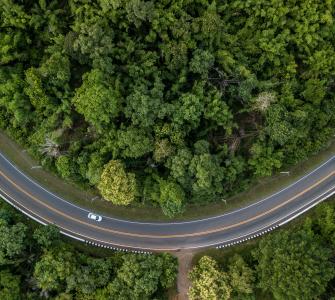Asia is home to some of the world’s most abundant biodiversity, complex ecosystems, and natural resources. The region's low-lying rainforests are responsible for valuable ecosystem services like carbon capture, underpin Gross Domestic Product, and secure countries’ long-term sustainability. However, to maintain current economic growth, it is estimated that Asia will need more than 1.7 trillion dollars in investment to rapidly build necessary transportation and power infrastructure. The construction of linear infrastructure, like roads, bridges, railways, and power lines, will fragment existing natural areas, contributing to rapid environmental degradation and threatening the livelihoods of millions of people who rely on land and natural resources for their survival.
Given the scope and potential consequences of this new linear infrastructure in Asia, the United States Agency for International Development (USAID) funded a project entitled Linear Infrastructure Safeguards in Asia (LISA), led by the Center for Large Landscape Conservation (CLLC) who partnered with CSF for economic expertise and guidance. The overall aim of the LISA project was to determine key interventions and environmental mitigation measures that can address future rapid infrastructure development in the region. The project evaluated ongoing and proposed infrastructure projects throughout Asia to: i) evaluate how well biodiversity is incorporated in planning and implementation phases, ii) review the current capacities of Asian officials in public and private sectors, iii) consider constraints to the implementation of environmental safeguards, and iv) assess the overall state of knowledge on the impacts of infrastructure on the environment. The project focused most on infrastructure development that threatens areas of high biodiversity, critical watersheds, and forest ecosystems.
One of the primary reasons that environmental safeguards such as wildlife crossings are not included in linear infrastructure projects is because they are perceived as too costly, and the resources to build them are not included in project budgets and financing. CSF provided expertise on the economic benefits of these safeguards, such as reductions in crop damages, vehicle collisions, and other human-wildlife conflict, in order to help justify investments in these important wildlife protection measures. CSF also provided input and guidance for incorporating economics into the evaluation of the capacity of Asian countries to safeguard biodiversity from linear infrastructure impacts. And lastly, CSF developed a training module for infrastructure professionals throughout Asia on economic analysis tools and examples for better linear infrastructure development in rural areas.
Through this project, CSF had the opportunity to use our strengths and deep experience in evaluating infrastructure development and conducting economic analysis of environmental and social costs during infrastructure planning phases, in order to help promote more sustainable and resilient development across Asia.
This project was made possible by the United States Agency for International Development and the generous support of the American People through the Engineering Surge Support AID-OAA-TO-16-00028 Work Assignment 13 Linear Infrastructure Safeguards in Asia (LISA).
Learn more about this project and find the reports here.
Photo credit: Shutterstock.com

